Timothy J. O'Shea
Transformer-Driven Neural Beamforming with Imperfect CSI in Urban Macro Wireless Channels
Apr 15, 2025

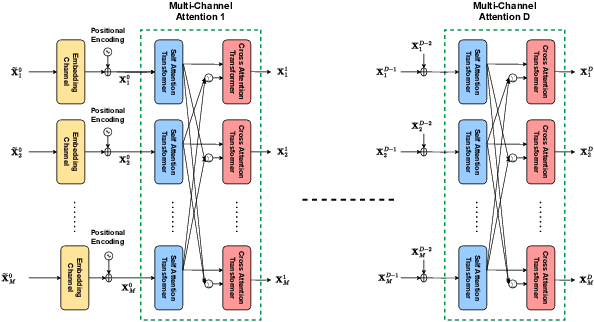

Abstract:The literature is abundant with methodologies focusing on using transformer architectures due to their prominence in wireless signal processing and their capability to capture long-range dependencies via attention mechanisms. In particular, depthwise separable convolutions enhance parameter efficiency for the process of high-dimensional data characteristics of MIMO systems. In this work, we introduce a novel unsupervised deep learning framework that integrates depthwise separable convolutions and transformers to generate beamforming weights under imperfect channel state information (CSI) for a multi-user single-input multiple-output (MU-SIMO) system in dense urban environments. The primary goal is to enhance throughput by maximizing sum-rate while ensuring reliable communication. Spectral efficiency and block error rate (BLER) are considered as performance metrics. Experiments are carried out under various conditions to compare the performance of the proposed NNBF framework against baseline methods zero-forcing beamforming (ZFBF) and minimum mean square error (MMSE) beamforming. Experimental results demonstrate the superiority of the proposed framework over the baseline techniques.
Digital Twin Enabled Site Specific Channel Precoding: Over the Air CIR Inference
Jan 27, 2025Abstract:This paper investigates the significance of designing a reliable, intelligent, and true physical environment-aware precoding scheme by leveraging an accurately designed channel twin model to obtain realistic channel state information (CSI) for cellular communication systems. Specifically, we propose a fine-tuned multi-step channel twin design process that can render CSI very close to the CSI of the actual environment. After generating a precise CSI, we execute precoding using the obtained CSI at the transmitter end. We demonstrate a two-step parameters' tuning approach to design channel twin by ray tracing (RT) emulation, then further fine-tuning of CSI by employing an artificial intelligence (AI) based algorithm can significantly reduce the gap between actual CSI and the fine-tuned digital twin (DT) rendered CSI. The simulation results show the effectiveness of the proposed novel approach in designing a true physical environment-aware channel twin model.
How Critical is Site-Specific RAN Optimization? 5G Open-RAN Uplink Air Interface Performance Test and Optimization from Macro-Cell CIR Data
Oct 25, 2024



Abstract:In this paper, we consider the importance of channel measurement data from specific sites and its impact on air interface optimization and test. Currently, a range of statistical channel models including 3GPP 38.901 tapped delay line (TDL), clustered delay line (CDL), urban microcells (UMi) and urban macrocells (UMa) type channels are widely used for air interface performance testing and simulation. However, there remains a gap in the realism of these models for air interface testing and optimization when compared with real world measurement based channels. To address this gap, we compare the performance impacts of training neural receivers with 1) statistical 3GPP TDL models, and 2) measured macro-cell channel impulse response (CIR) data. We leverage our OmniPHY-5G neural receiver for NR PUSCH uplink simulation, with a training procedure that uses statistical TDL channel models for pre-training, and fine-tuning based on measured site specific MIMO CIR data. The proposed fine-tuning method achieves a 10% block error rate (BLER) at a 1.85 dB lower signal-to-noise ratio (SNR) compared to pre-training only on simulated TDL channels, illustrating a rough magnitude of the gap that can be closed by site-specific training, and gives the first answer to the question "how much can fine-tuning the RAN for site-specific channels help?"
Deep Learning Based Joint Multi-User MISO Power Allocation and Beamforming Design
Jun 12, 2024



Abstract:The evolution of fifth generation (5G) wireless communication networks has led to an increased need for wireless resource management solutions that provide higher data rates, wide coverage, low latency, and power efficiency. Yet, many of existing traditional approaches remain non-practical due to computational limitations, and unrealistic presumptions of static network conditions and algorithm initialization dependencies. This creates an important gap between theoretical analysis and real-time processing of algorithms. To bridge this gap, deep learning based techniques offer promising solutions with their representational capabilities for universal function approximation. We propose a novel unsupervised deep learning based joint power allocation and beamforming design for multi-user multiple-input single-output (MU-MISO) system. The objective is to enhance the spectral efficiency by maximizing the sum-rate with the proposed joint design framework, NNBF-P while also offering computationally efficient solution in contrast to conventional approaches. We conduct experiments for diverse settings to compare the performance of NNBF-P with zero-forcing beamforming (ZFBF), minimum mean square error (MMSE) beamforming, and NNBF, which is also our deep learning based beamforming design without joint power allocation scheme. Experiment results demonstrate the superiority of NNBF-P compared to ZFBF, and MMSE while NNBF can have lower performances than MMSE and ZFBF in some experiment settings. It can also demonstrate the effectiveness of joint design framework with respect to NNBF.
Deep Learning Based Uplink Multi-User SIMO Beamforming Design
Sep 28, 2023
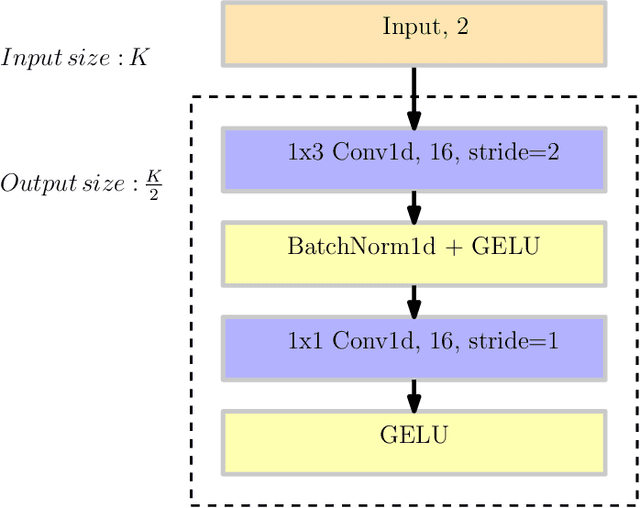

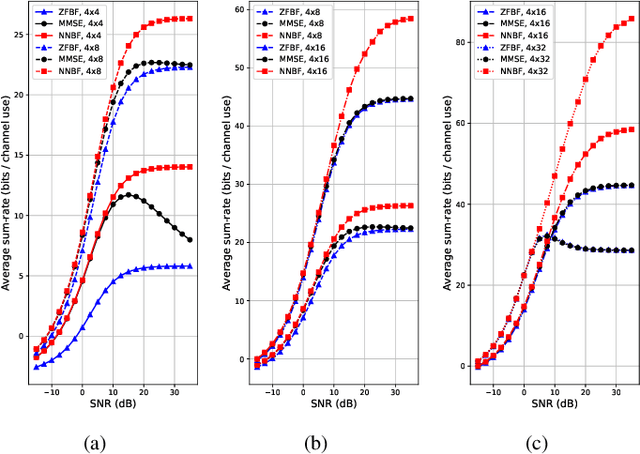
Abstract:The advancement of fifth generation (5G) wireless communication networks has created a greater demand for wireless resource management solutions that offer high data rates, extensive coverage, minimal latency and energy-efficient performance. Nonetheless, traditional approaches have shortcomings when it comes to computational complexity and their ability to adapt to dynamic conditions, creating a gap between theoretical analysis and the practical execution of algorithmic solutions for managing wireless resources. Deep learning-based techniques offer promising solutions for bridging this gap with their substantial representation capabilities. We propose a novel unsupervised deep learning framework, which is called NNBF, for the design of uplink receive multi-user single input multiple output (MU-SIMO) beamforming. The primary objective is to enhance the throughput by focusing on maximizing the sum-rate while also offering computationally efficient solution, in contrast to established conventional methods. We conduct experiments for several antenna configurations. Our experimental results demonstrate that NNBF exhibits superior performance compared to our baseline methods, namely, zero-forcing beamforming (ZFBF) and minimum mean square error (MMSE) equalizer. Additionally, NNBF is scalable to the number of single-antenna user equipments (UEs) while baseline methods have significant computational burden due to matrix pseudo-inverse operation.
Benchmarking and Interpreting End-to-end Learning of MIMO and Multi-User Communication
Mar 15, 2022
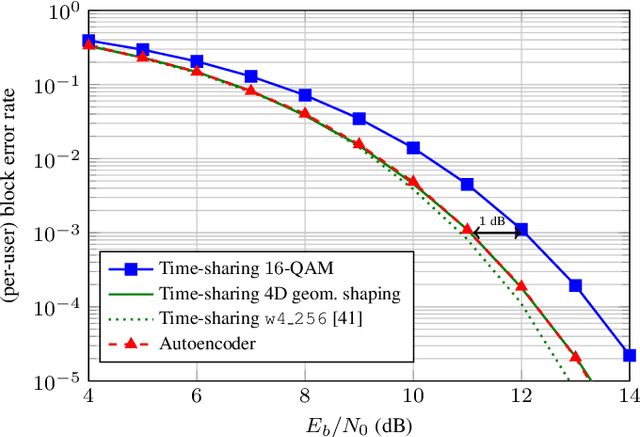
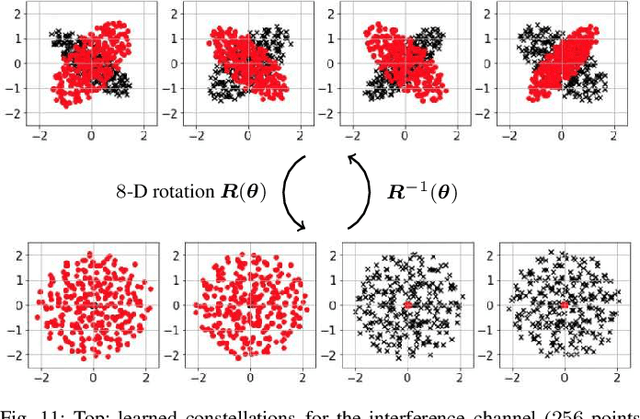

Abstract:End-to-end autoencoder (AE) learning has the potential of exceeding the performance of human-engineered transceivers and encoding schemes, without a priori knowledge of communication-theoretic principles. In this work, we aim to understand to what extent and for which scenarios this claim holds true when comparing with fair benchmarks. Our particular focus is on memoryless multiple-input multiple-output (MIMO) and multi-user (MU) systems. Four case studies are considered: two point-to-point (closed-loop and open-loop MIMO) and two MU scenarios (MIMO broadcast and interference channels). For the point-to-point scenarios, we explain some of the performance gains observed in prior work through the selection of improved baseline schemes that include geometric shaping as well as bit and power allocation. For the MIMO broadcast channel, we demonstrate the feasibility of a novel AE method with centralized learning and decentralized execution. Interestingly, the learned scheme performs close to nonlinear vector-perturbation precoding and significantly outperforms conventional zero-forcing. Lastly, we highlight potential pitfalls when interpreting learned communication schemes. In particular, we show that the AE for the considered interference channel learns to avoid interference, albeit in a rotated reference frame. After de-rotating the learned signal constellation of each user, the resulting scheme corresponds to conventional time sharing with geometric shaping.
SVD-Embedded Deep Autoencoder for MIMO Communications
Nov 03, 2021


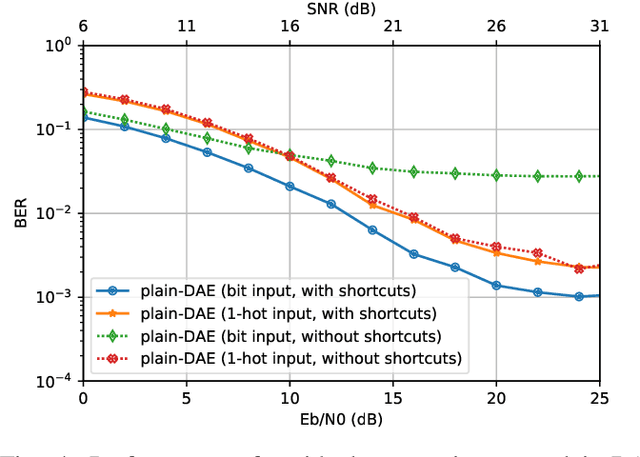
Abstract:Using a deep autoencoder (DAE) for end-to-end communication in multiple-input multiple-output (MIMO) systems is a novel concept with significant potential. DAE-aided MIMO has been shown to outperform singular-value decomposition (SVD)-based precoded MIMO in terms of bit error rate (BER). This paper proposes embedding left- and right-singular vectors of the channel matrix into DAE encoder and decoder to further improve the performance of MIMO spatial multiplexing. SVD-embedded DAE largely outperforms theoretic linear precoding in terms of BER. This is remarkable since it demonstrates that the proposed DAEs have significant potential to exceed the limits of current system design by treating the communication system as a single, end-to-end optimization block. Based on the simulation results, at SNR=10dB, the proposed SVD-embedded design can achieve BER nearly $10^{-5}$ and reduce the BER at least 10 times compared with existing DAE without SVD, and up to 18 times improvement compared with theoretical linear precoding. We attribute this to the fact that the proposed DAE can match the input and output as an adaptive modulation structure with finite alphabet input. We also observe that adding residual connections to the DAE further improves the performance.
Deep Learning for Wireless Communications
May 12, 2020
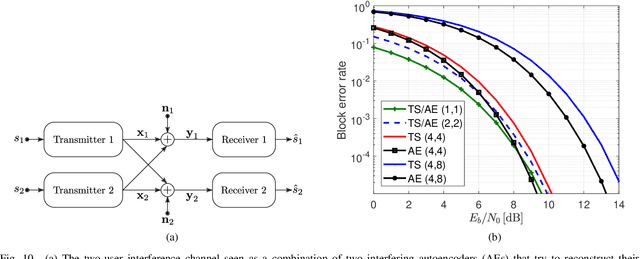
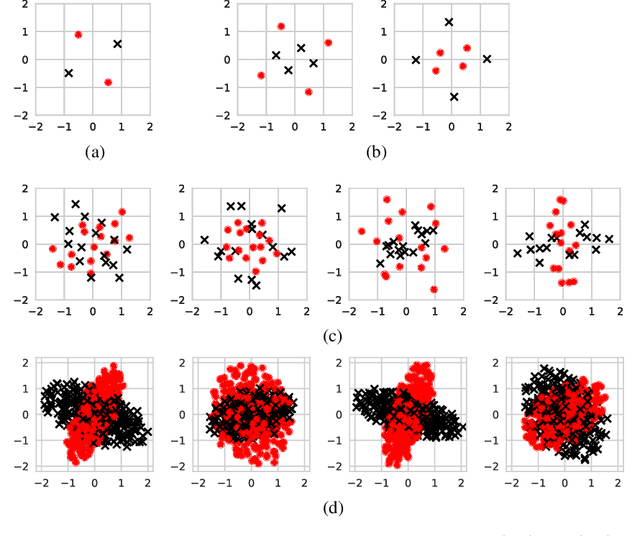
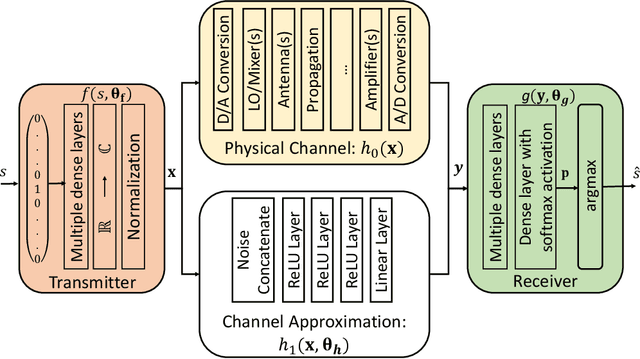
Abstract:Existing communication systems exhibit inherent limitations in translating theory to practice when handling the complexity of optimization for emerging wireless applications with high degrees of freedom. Deep learning has a strong potential to overcome this challenge via data-driven solutions and improve the performance of wireless systems in utilizing limited spectrum resources. In this chapter, we first describe how deep learning is used to design an end-to-end communication system using autoencoders. This flexible design effectively captures channel impairments and optimizes transmitter and receiver operations jointly in single-antenna, multiple-antenna, and multiuser communications. Next, we present the benefits of deep learning in spectrum situation awareness ranging from channel modeling and estimation to signal detection and classification tasks. Deep learning improves the performance when the model-based methods fail. Finally, we discuss how deep learning applies to wireless communication security. In this context, adversarial machine learning provides novel means to launch and defend against wireless attacks. These applications demonstrate the power of deep learning in providing novel means to design, optimize, adapt, and secure wireless communications.
Approximating the Void: Learning Stochastic Channel Models from Observation with Variational Generative Adversarial Networks
Aug 20, 2018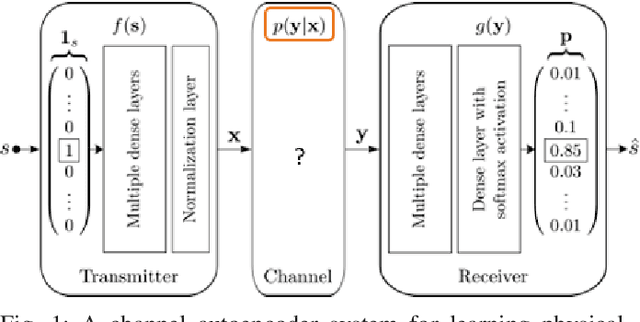

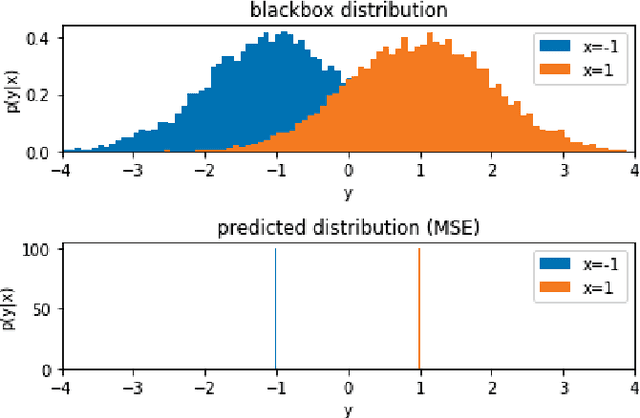
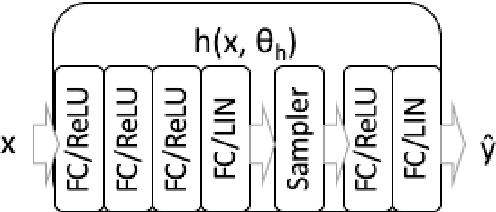
Abstract:Channel modeling is a critical topic when considering designing, learning, or evaluating the performance of any communications system. Most prior work in designing or learning new modulation schemes has focused on using highly simplified analytic channel models such as additive white Gaussian noise (AWGN), Rayleigh fading channels or similar. Recently, we proposed the usage of a generative adversarial networks (GANs) to jointly approximate a wireless channel response model (e.g. from real black box measurements) and optimize for an efficient modulation scheme over it using machine learning. This approach worked to some degree, but was unable to produce accurate probability distribution functions (PDFs) representing the stochastic channel response. In this paper, we focus specifically on the problem of accurately learning a channel PDF using a variational GAN, introducing an architecture and loss function which can accurately capture stochastic behavior. We illustrate where our prior method failed and share results capturing the performance of such as system over a range of realistic channel distributions.
Physical Layer Communications System Design Over-the-Air Using Adversarial Networks
Mar 08, 2018



Abstract:This paper presents a novel method for synthesizing new physical layer modulation and coding schemes for communications systems using a learning-based approach which does not require an analytic model of the impairments in the channel. It extends prior work published on the channel autoencoder to consider the case where the channel response is not known or can not be easily modeled in a closed form analytic expression. By adopting an adversarial approach for channel response approximation and information encoding, we can jointly learn a good solution to both tasks over a wide range of channel environments. We describe the operation of the proposed adversarial system, share results for its training and validation over-the-air, and discuss implications and future work in the area.
 Add to Chrome
Add to Chrome Add to Firefox
Add to Firefox Add to Edge
Add to Edge